
Old growth forest, Lake Florence Creek, Admiralty Island, Tongass National Forest, Alaska.
The Biden Administration supports protecting 30% of US lands by 2030 or what is termed the 30 x 30 proposal. One of the best ways to meet that 30 by 30 goals would be to put all national forests and BLM lands off-limits to logging.
Not only does this help to move the country closer to the 30 x 30 goals, but it would go a long way towards sequestering carbon as well.
Our public forests currently hold about 7 times the current annual national carbon emissions and US forests sequester about 12% of the country’s carbon emissions.
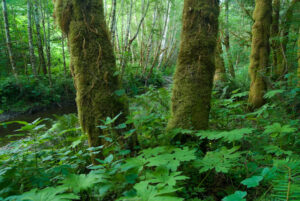
Headwaters Forest Reserve sequestering carbon on BLM lands in northern California. Photo by George Wuerthner.
If we stopped logging and thinning our federal forests, we could sequester even more carbon.
However, the Forest Service, the timber industry, and co-opted conservation groups continue to support thinning the forest in the name of precluding large wildfires.
Unfortunately, advocates of thinning mislead Americans on the limited effectiveness of thinning in precluding large blazes. Plus logging contributes more carbon to the atmosphere that exacerbates fire weather.
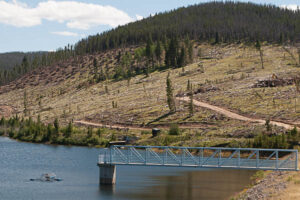
Thinning (clearcut?) on the Helena NF in the name of fire prevention. Photo by George Wuerthner.
The problem with the thinning will limit large fires myth is that it ignores the influence of extreme fire weather. Thinning might, in some instances, slow or stop blazes burning under low to moderate fire conditions, but not under extreme fire weather. Under less than extreme weather, most fires are easily suppressed or even self-extinguish if we leave them alone.
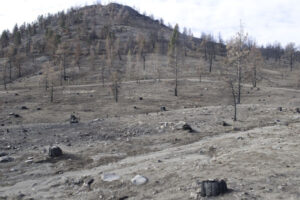
High severity fire that burned through a forest on BLM land by Helena, Montana that was thinned just months before. The blackened tops of cut trees indicated that these were cut prior to the fire. The wind was blowing 50 mph. Photo by George Wuerthner.
All large fires are driven by extreme weather. And these are the fires that the agency, politicians and others seek to stop, but under such conditions, the scientific consensus is that nothing can stop a blaze. Wind-driven fires pass over, around, and through thinned forests and prescribed burning sites.
Second, there is a low likelihood that any treated forests will be exposed to fire. So most thinning projects remove carbon, but they do nothing to reduce large blazes.
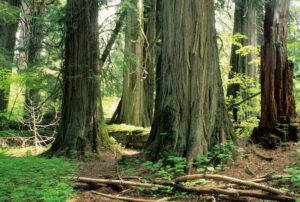
Old-growth western red cedar Ohanapecoch River, Washington Photo by George Wuerthner.
As one study concluded: “the amount of carbon removed to change fire behavior is often far larger than that saved by changing fire behavior, and more area has to be harvested than will ultimately burn over the period of effectiveness of the thinning treatment.”
Another researcher suggests: “Reducing the fraction by which C is lost in a wildfire requires the removal of a much greater amount of C, since most of the C stored in forest biomass (stem wood, branches, coarse woody debris) remains unconsumed even by high-severity wildfires.”
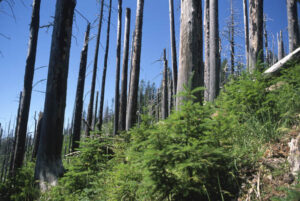
The snags left behind after a high severity blaze continue to store carbon and new growth sequesters even more. Warner Creek, Willamette NF, Oregon. Photo by George Wuerthner.
The misconception that many hold is that fires release a lot of GHG emissions. Burning does release some carbon, but the majority of the carbon in the forest remains on site even after a severe fire. The snags left after a blaze contain much of the carbon found in a forest, while charcoal that is retained in the soil stores even more carbon.
By contrast, logging releases a tremendous of carbon.
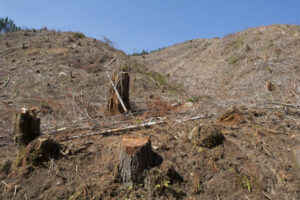
Clearcut in Oregon’s Coast Range removes the majority of all carbon from the site. Photo by George Wuerthner .
That is one reason the biggest sources of Green House Gas (GHG) in Oregon is logging which accounts for 35% of the state’s emissions.
The other problem is that recovering that carbon lost during thinning/logging takes decades to centuries and we need to reduce carbon emissions now.

Thinned forest (looks like a clearcut to me) on the Deschutes National Forest, Oregon. Such thinning projects do not preclude large fires under extreme fire weather. Photo by George Wuerthner.
Surprisingly, many conservation groups, on hand claim that climate change is the biggest threat to the future of the planet, yet the same groups support thinning the forest in the name of fire exclusion and at times even burning logging residue for biomass energy.
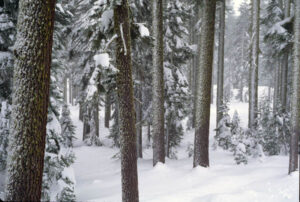
Old-growth red fir forest in snow. Mount Shasta, Shasta Trinity NF, CA. These forests should be off-limits to logging to preserve carbon storage. Photo by George Wuerthner.
The highest value of our public forests is their function as carbon reserves. Prohibiting logging would not only help sequester more carbon, but provide numerous other benefits such as watershed protection, protection of wildlife habitat, preserving the ecological function of insect, wildfire, and drought that creates healthy forest ecosystems.